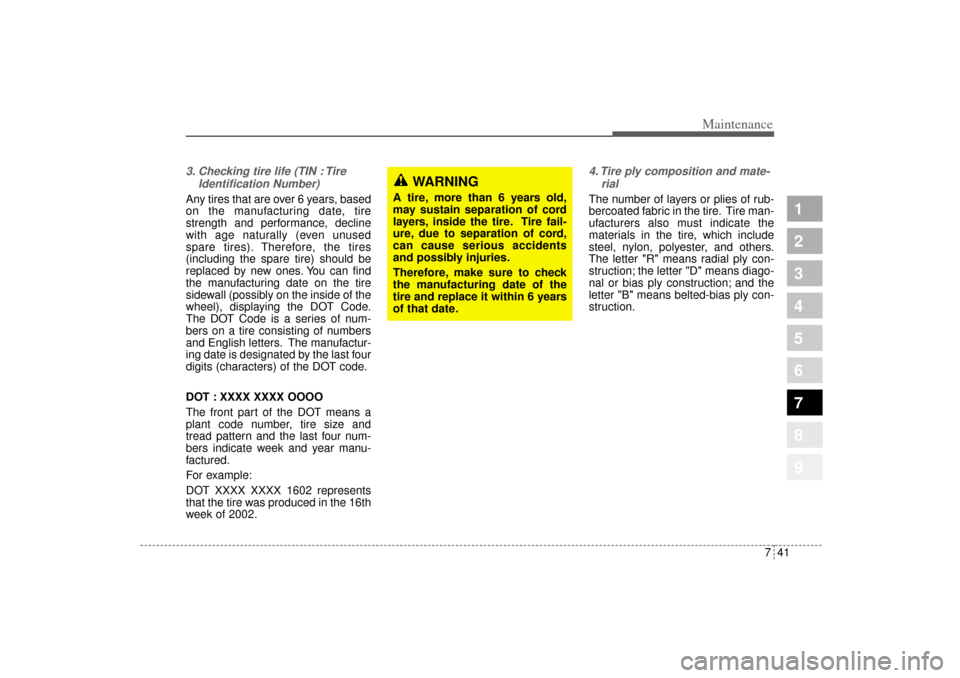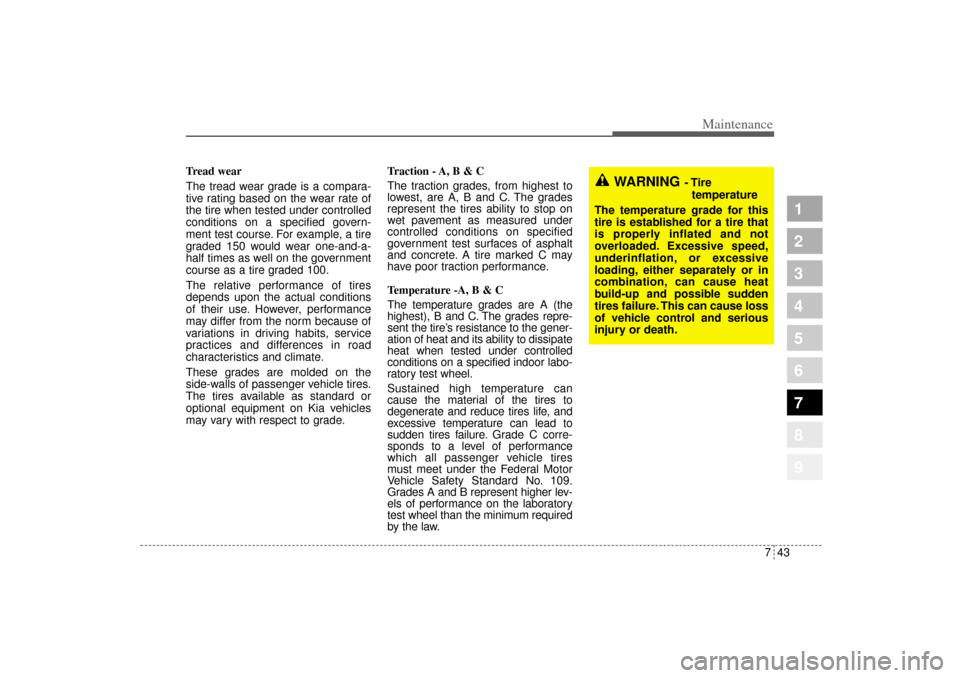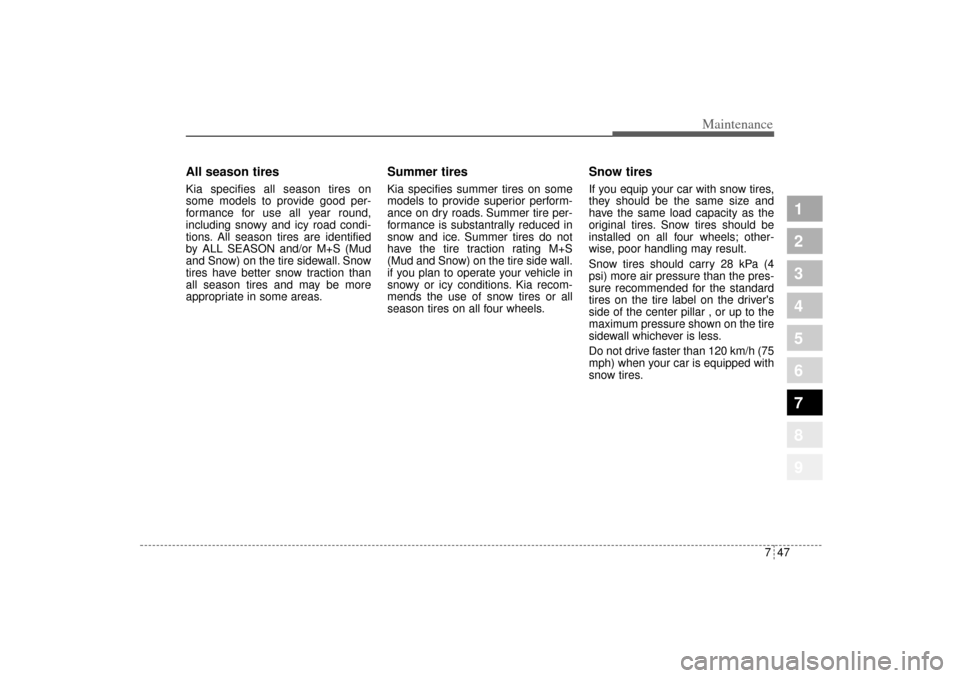Page 334 of 354

741
Maintenance
1
2
3
4
5
6
7
8
9
3. Checking tire life (TIN : Tire
Identification Number) Any tires that are over 6 years, based
on the manufacturing date, tire
strength and performance, decline
with age naturally (even unused
spare tires). Therefore, the tires
(including the spare tire) should be
replaced by new ones. You can find
the manufacturing date on the tire
sidewall (possibly on the inside of the
wheel), displaying the DOT Code.
The DOT Code is a series of num-
bers on a tire consisting of numbers
and English letters. The manufactur-
ing date is designated by the last four
digits (characters) of the DOT code.
DOT : XXXX XXXX OOOO
The front part of the DOT means a
plant code number, tire size and
tread pattern and the last four num-
bers indicate week and year manu-
factured.
For example:
DOT XXXX XXXX 1602 represents
that the tire was produced in the 16th
week of 2002.
4. Tire ply composition and mate-
rialThe number of layers or plies of rub-
bercoated fabric in the tire. Tire man-
ufacturers also must indicate the
materials in the tire, which include
steel, nylon, polyester, and others.
The letter "R" means radial ply con-
struction; the letter "D" means diago-
nal or bias ply construction; and the
letter "B" means belted-bias ply con-
struction.
WARNING
A tire, more than 6 years old,
may sustain separation of cord
layers, inside the tire. Tire fail-
ure, due to separation of cord,
can cause serious accidents
and possibly injuries.
Therefore, make sure to check
the manufacturing date of the
tire and replace it within 6 years
of that date.
KM CAN (ENG) 7.qxd 9/13/2004 4:47 PM Page 41
Page 335 of 354
Maintenance42 7
1
2
3
4
5
6
7
8
9
5. Maximum permissible inflation
pressureThis number is the greatest amount
of air pressure that should be put in
the tire. Do not exceed the maximum
permissible inflation pressure. Refer
to the Tire and Loading Information
label for recommended inflation
pressure.
6. Maximum load ratingThis number indicates the maximum
load in kilograms and pounds that
can be carried by the tire. When
replacing the tires on the vehicle,
always use a tire that has the same
load rating as the factory installed
tire.
7. Uniform tire quality grading The following information relates to
the tire grading system developed by
the Canadian Motor Vehicle Safety
Standard (CMVSS) for grading tires
by tread wear, traction and tempera-
ture performance.
KM CAN (ENG) 7.qxd 9/13/2004 4:47 PM Page 42
Page 336 of 354

743
Maintenance
1
2
3
4
5
6
7
8
9
Tread wear
The tread wear grade is a compara-
tive rating based on the wear rate of
the tire when tested under controlled
conditions on a specified govern-
ment test course. For example, a tire
graded 150 would wear one-and-a-
half times as well on the government
course as a tire graded 100.
The relative performance of tires
depends upon the actual conditions
of their use. However, performance
may differ from the norm because of
variations in driving habits, service
practices and differences in road
characteristics and climate.
These grades are molded on the
side-walls of passenger vehicle tires.
The tires available as standard or
optional equipment on Kia vehicles
may vary with respect to grade.Traction - A, B & C
The traction grades, from highest to
lowest, are A, B and C. The grades
represent the tires ability to stop on
wet pavement as measured under
controlled conditions on specified
government test surfaces of asphalt
and concrete. A tire marked C may
have poor traction performance.
Temperature -A, B & C
The temperature grades are A (the
highest), B and C. The grades repre-
sent the tire’s resistance to the gener-
ation of heat and its ability to dissipate
heat when tested under controlled
conditions on a specified indoor labo-
ratory test wheel.
Sustained high temperature can
cause the material of the tires to
degenerate and reduce tires life, and
excessive temperature can lead to
sudden tires failure. Grade C corre-
sponds to a level of performance
which all passenger vehicle tires
must meet under the Federal Motor
Vehicle Safety Standard No. 109.
Grades A and B represent higher lev-
els of performance on the laboratory
test wheel than the minimum required
by the law.
WARNING
- Tire
temperature
The temperature grade for this
tire is established for a tire that
is properly inflated and not
overloaded. Excessive speed,
underinflation, or excessive
loading, either separately or in
combination, can cause heat
build-up and possible sudden
tires failure. This can cause loss
of vehicle control and serious
injury or death.
KM CAN (ENG) 7.qxd 9/13/2004 4:47 PM Page 43
Page 340 of 354

747
Maintenance
1
2
3
4
5
6
7
8
9
All season tires Kia specifies all season tires on
some models to provide good per-
formance for use all year round,
including snowy and icy road condi-
tions. All season tires are identified
by ALL SEASON and/or M+S (Mud
and Snow) on the tire sidewall. Snow
tires have better snow traction than
all season tires and may be more
appropriate in some areas.
Summer tires Kia specifies summer tires on some
models to provide superior perform-
ance on dry roads. Summer tire per-
formance is substantrally reduced in
snow and ice. Summer tires do not
have the tire traction rating M+S
(Mud and Snow) on the tire side wall.
if you plan to operate your vehicle in
snowy or icy conditions. Kia recom-
mends the use of snow tires or all
season tires on all four wheels.
Snow tiresIf you equip your car with snow tires,
they should be the same size and
have the same load capacity as the
original tires. Snow tires should be
installed on all four wheels; other-
wise, poor handling may result.
Snow tires should carry 28 kPa (4
psi) more air pressure than the pres-
sure recommended for the standard
tires on the tire label on the driver's
side of the center pillar , or up to the
maximum pressure shown on the tire
sidewall whichever is less.
Do not drive faster than 120 km/h (75
mph) when your car is equipped with
snow tires.
KM CAN (ENG) 7.qxd 9/13/2004 4:47 PM Page 47
Page 352 of 354
Specifications4 8
1
2
3
4
5
6
7
8
9
Gear ratioTires
Item Inflation Pressure
Wheel lug nut torque
Tire Wheel kPa (psi) kg·m (lb·ft, N·m)
P215/65R16 96T 6.5J x 16 210 (30)9~11
(65~79, 88~107)
P235/60R16 99T 6.5J x 16 210 (30)9~11
(65~79, 88~107)
Compact spare tire
T155/90R16 110M 4.0T x 16 420 (60)9~11
(65~79, 88~107)
Engine 2.0L
Engine
2.7L
Engine
Gear Manual transaxle Automatic transaxle Automatic transaxle
1st 3.636 2.842 2.842
2nd 2.056 1.529 1.529
3rd 1.333 1.000 1.000
4th 1.061 0.712 0.712
5th 0.821 - -
Reverse 3.455 2.480 2.480
F.G.R2WD
4.533 4.6264.042
4WD 4.407
KM CAN (ENG) 8.qxd 9/13/2004 4:04 PM Page 4